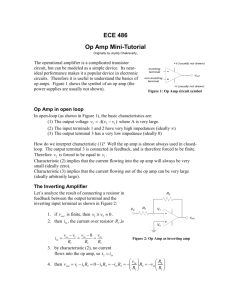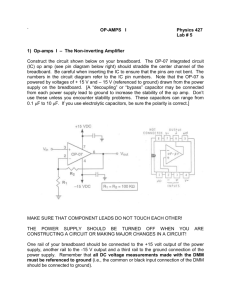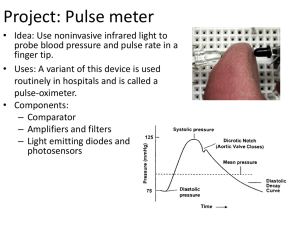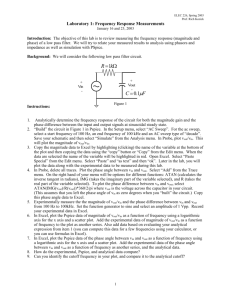ENG 220 Operational amplifiers LAB -4
advertisement
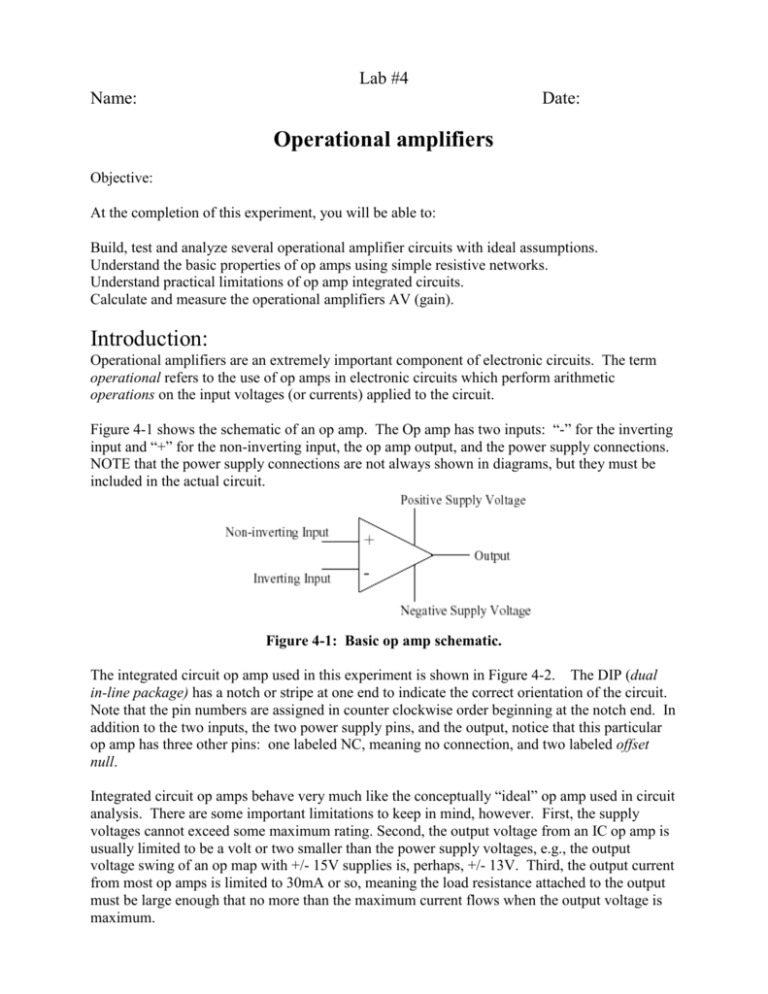
Lab #4 Name: Date: Operational amplifiers Objective: At the completion of this experiment, you will be able to: Build, test and analyze several operational amplifier circuits with ideal assumptions. Understand the basic properties of op amps using simple resistive networks. Understand practical limitations of op amp integrated circuits. Calculate and measure the operational amplifiers AV (gain). Introduction: Operational amplifiers are an extremely important component of electronic circuits. The term operational refers to the use of op amps in electronic circuits which perform arithmetic operations on the input voltages (or currents) applied to the circuit. Figure 4-1 shows the schematic of an op amp. The Op amp has two inputs: “-” for the inverting input and “+” for the non-inverting input, the op amp output, and the power supply connections. NOTE that the power supply connections are not always shown in diagrams, but they must be included in the actual circuit. Figure 4-1: Basic op amp schematic. The integrated circuit op amp used in this experiment is shown in Figure 4-2. The DIP (dual in-line package) has a notch or stripe at one end to indicate the correct orientation of the circuit. Note that the pin numbers are assigned in counter clockwise order beginning at the notch end. In addition to the two inputs, the two power supply pins, and the output, notice that this particular op amp has three other pins: one labeled NC, meaning no connection, and two labeled offset null. Integrated circuit op amps behave very much like the conceptually “ideal” op amp used in circuit analysis. There are some important limitations to keep in mind, however. First, the supply voltages cannot exceed some maximum rating. Second, the output voltage from an IC op amp is usually limited to be a volt or two smaller than the power supply voltages, e.g., the output voltage swing of an op map with +/- 15V supplies is, perhaps, +/- 13V. Third, the output current from most op amps is limited to 30mA or so, meaning the load resistance attached to the output must be large enough that no more than the maximum current flows when the output voltage is maximum. Figure 4-2: 741 op amp pin-out diagram. It is common to include power supply bypass capacitors in op amp circuit designs. This means connecting small (typically 0.01μF) capacitors between the supply voltage and the circuit ground, as shown in Figure 4-3. Figure 4-3: Op amp with power supply bypass capacitors. Experiment simulation: (1) Many different types of op amps are available from commercial manufacturers. We are using 741 op amps in this lab. Using Multisim build and test a non- inverting amplifier circuit like the figure below (4-4). Use V+ = +12 volts to IC pin 7 and use V- = -12 volts to IC pin 4. Record the input and output voltages as you vary Vinput DC voltage from +1 volt to +6 volts in small volt steps (1volt). You will want to use smaller steps near the output saturation levels in order to determine for what input the output begins to saturate. Figure 4-4: Non-inverting amplifier circuit. at Vin= at Vin= at Vin= Vout= Vout= Vout= at Vin= at Vin= at Vin= Vout= Vout= Vout= saturation Are simulation and calculated gain close ? Calculate the percent error. (2) Using Multisim build and test an inverting amplifier circuit like the figure 1. Use V+ = +12 volts to IC pin 7 and use V- = -12 volts to IC pin 4. Record the input and output voltages as you vary Vin DC voltage. Figure 1: Inverting amplifier circuit. at Vin=-1v at Vin=-3v at Vin=-5v Vout= Vout= Vout= at Vin=-2v at Vin=-4v at Vin= -6v Are simulation and calculated gain close ? Calculate the percent error. Vout= Vout= Vout= Using Multisim build and test an inverting summing amplifier circuit like the figure below (4-6). Use V+ = +12 volts to IC pin 7 and use V- = -12 volts to IC pin 4. Record the inputs (V1, V2, and V3) and output voltages as you vary Vin DC voltages (V1, V2, and V3) from -1volt to -6 volts in 1 volt steps. Figure 4-6: Inverting summer circuit. Are simulation and calculated gain are close ? Calculate the percent error for the best case. Experiment: Build and test (3) Assemble the inverting amplifier circuit of Figure 1. Measure and record the actual value of the resistors. Remember the power supply connections: use V+ = +12 volts to IC pin 7 and use V- = -12 volts to IC pin 4. Include 0.01μF bypass capacitors between the +12V and ground and between the -12V and ground, placing the capacitors as close to the IC as possible. Record the input and output voltages as you vary Vin DC voltage from -1 volt to -6 volts in 1 volt steps. You will want to use smaller steps near the output saturation levels in order to determine for what input the output begins to saturate. Are simulation and measured gain close ? Calculate the percent error. Now use the signal generator for Vin for the inverting amplifier in Figure 1. Observe the signal generator signal on channel 1 of the oscilloscope and the op amp output on channel 2. Make sure the ‘scope inputs are set for DC coupling. Adjust the signal generator for a sine wave with a ~500Hz frequency, and adjust the amplitude so that the signal out of the op amp is 2 volts peakto-peak. Draw the waveform seen on the display and record the voltage from top to bottom of the square wave. Determine the output peak-to-peak voltage. Present your measurements from part (4) of the experiment in the form of a graph with Vin as the abscissa (x-axis) and Vo as the ordinate (y-axis). Label your plot. What is the slope of the curve? Does it pass exactly through the origin? How does the result compare to your prediction using the ideal op amp model?
